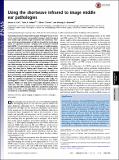| dc.contributor.author | Bruns, Oliver T. | |
| dc.contributor.author | Carr, Jessica Ann | |
| dc.contributor.author | Valdez Vargas, Tulio | |
| dc.contributor.author | Bawendi, Moungi G | |
| dc.date.accessioned | 2017-05-08T13:10:13Z | |
| dc.date.available | 2017-05-08T13:10:13Z | |
| dc.date.issued | 2016-08 | |
| dc.date.submitted | 2016-02 | |
| dc.identifier.issn | 0027-8424 | |
| dc.identifier.issn | 1091-6490 | |
| dc.identifier.uri | http://hdl.handle.net/1721.1/108725 | |
| dc.description.abstract | Visualizing structures deep inside opaque biological tissues is one of the central challenges in biomedical imaging. Optical imaging with visible light provides high resolution and sensitivity; however, scattering and absorption of light by tissue limits the imaging depth to superficial features. Imaging with shortwave infrared light (SWIR, 1–2 μm) shares many advantages of visible imaging, but light scattering in tissue is reduced, providing sufficient optical penetration depth to noninvasively interrogate subsurface tissue features. However, the clinical potential of this approach has been largely unexplored because suitable detectors, until recently, have been either unavailable or cost prohibitive. Here, taking advantage of newly available detector technology, we demonstrate the potential of SWIR light to improve diagnostics through the development of a medical otoscope for determining middle ear pathologies. We show that SWIR otoscopy has the potential to provide valuable diagnostic information complementary to that provided by visible pneumotoscopy. We show that in healthy adult human ears, deeper tissue penetration of SWIR light allows better visualization of middle ear structures through the tympanic membrane, including the ossicular chain, promontory, round window niche, and chorda tympani. In addition, we investigate the potential for detection of middle ear fluid, which has significant implications for diagnosing otitis media, the overdiagnosis of which is a primary factor in increased antibiotic resistance. Middle ear fluid shows strong light absorption between 1,400 and 1,550 nm, enabling straightforward fluid detection in a model using the SWIR otoscope. Moreover, our device is easily translatable to the clinic, as the ergonomics, visual output, and operation are similar to a conventional otoscope. | en_US |
| dc.description.sponsorship | United States. National Institutes of Health (9-P41-EB015871-26A1) | en_US |
| dc.description.sponsorship | Massachusetts Institute of Technology. Institute for Soldier Nanotechnologies (W911NF-13-D-0001) | en_US |
| dc.language.iso | en_US | |
| dc.publisher | National Academy of Sciences (U.S.) | en_US |
| dc.relation.isversionof | http://dx.doi.org/10.1073/pnas.1610529113 | en_US |
| dc.rights | Article is made available in accordance with the publisher's policy and may be subject to US copyright law. Please refer to the publisher's site for terms of use. | en_US |
| dc.source | PNAS | en_US |
| dc.title | Using the shortwave infrared to image middle ear pathologies | en_US |
| dc.type | Article | en_US |
| dc.identifier.citation | Carr, Jessica A.; Valdez, Tulio A.; Bruns, Oliver T. and Bawendi, Moungi G. “Using the Shortwave Infrared to Image Middle Ear Pathologies.” Proceedings of the National Academy of Sciences 113, no. 36 (August 2016): 9989–9994.© 2016 National Academy of Sciences. | en_US |
| dc.contributor.department | Massachusetts Institute of Technology. Department of Chemistry | en_US |
| dc.contributor.mitauthor | Carr, Jessica Ann | |
| dc.contributor.mitauthor | Valdez Vargas, Tulio | |
| dc.contributor.mitauthor | Bawendi, Moungi G | |
| dc.relation.journal | Proceedings of the National Academy of Sciences | en_US |
| dc.eprint.version | Final published version | en_US |
| dc.type.uri | http://purl.org/eprint/type/JournalArticle | en_US |
| eprint.status | http://purl.org/eprint/status/PeerReviewed | en_US |
| dspace.orderedauthors | Carr, Jessica A.; Valdez, Tulio A.; Bruns, Oliver T.; Bawendi, Moungi G. | en_US |
| dspace.embargo.terms | N | en_US |
| dc.identifier.orcid | https://orcid.org/0000-0001-8637-8108 | |
| dc.identifier.orcid | https://orcid.org/0000-0002-6761-0845 | |
| dc.identifier.orcid | https://orcid.org/0000-0003-2220-4365 | |
| mit.license | PUBLISHER_POLICY | en_US |
| mit.metadata.status | Complete | |
